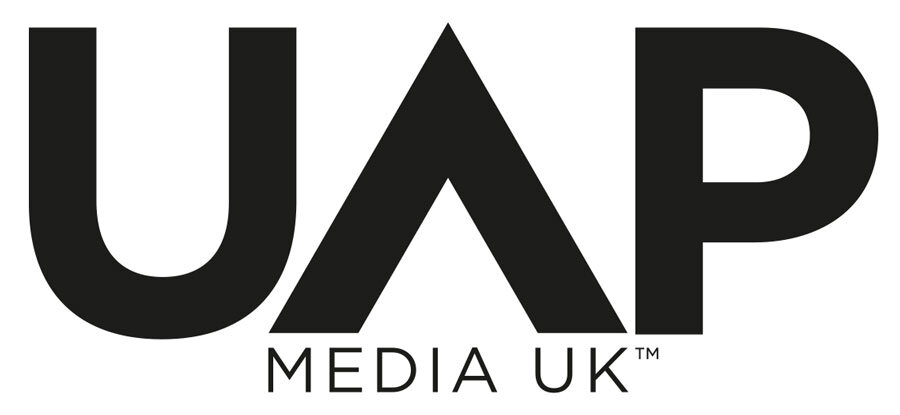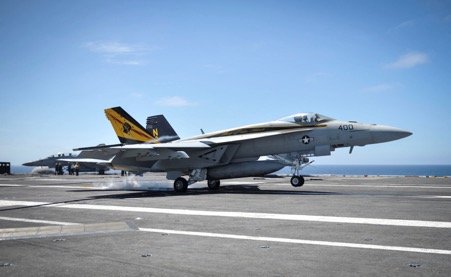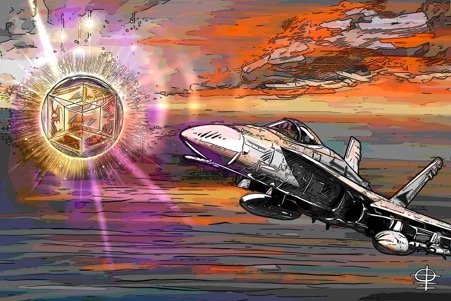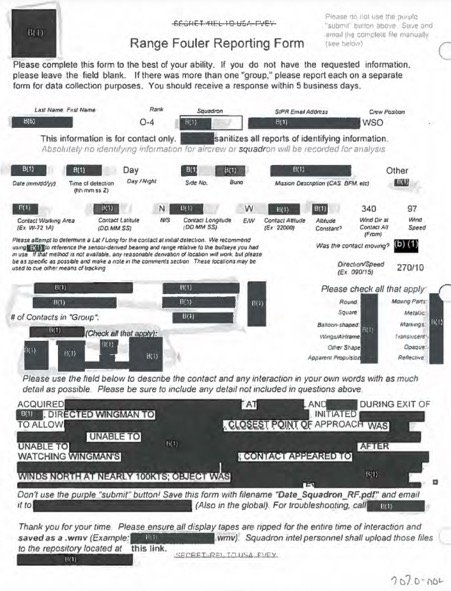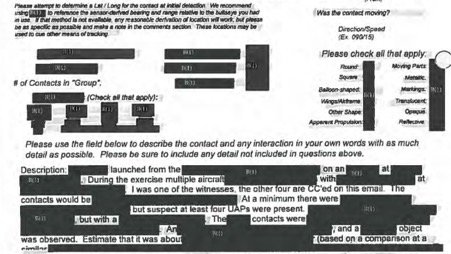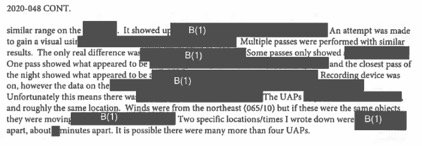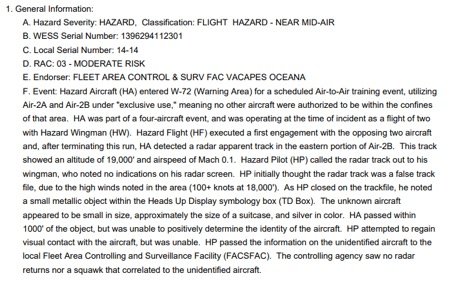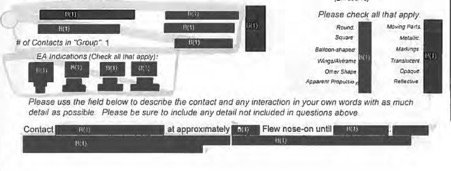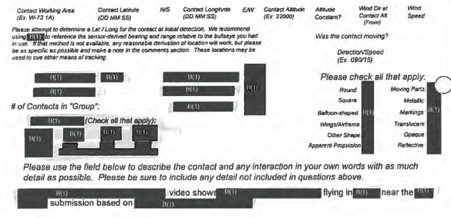RANGE FOULERS AND REDACTED REPORTS
ENCOUNTERS BETWEEN US Navy aircraft and Unidentified Aerial Phenomena (UAP) is nothing new. I have written at length about sightings reported by naval aircrew during World War Two, the late 1940s and early 1950s in UFOs Before Roswell, Dawn of the Flying Saucers and Flying Saucer Fever. However, given that UFOs are more closely associated with the US Air Force (USAF) by the public due to the long running existence of Project Blue Book (1952-1969), plus suggestions that the USAF themselves have been part of a conspiracy to hide the scale and reality of the phenomena, then it is not surprising that for years, the US Navy has taken a back seat in discussions about the subject.
A VFA-25 F/A-18E Super Hornet lands on the flight deck of USS Nimitz (CVN-68) in the Pacific Ocean on 10th September 2014. Similar jets from US Navy active duty, training and testing squadrons have been involved in numerous encounters with UAP over the last 20 years. (US Navy photo, public domain)Folks who keep a close watch on what is happening UAP-wise know that is no longer true. If anything, over the last two decades at least, the US Navy has – perhaps unwillingly – been thrust into the UFO limelight due to a series of high profile incidents, many of which have involved its aircrews. Of course, this information only really started to appear on the public’s horizon in December 2017, when the infamous Forward-Looking Infra-Red (FLIR) video footage of anomalous objects were released, plus subsequent revelations by serving (and now former) aircrew of encounters with mysterious items over military exercise areas out at sea. These encounters with so-called “Range Foulers” are now very well-documented although the nature of the UAP in question appears to remain unknown.
Fast-forward to June 2021 and the release of the UAP Task Force’s Preliminary Assessment provided onlookers with a summary of the incidents included in their report – 144 reports, none of which came from the USAF. US Navy personnel were once again front and centre in the experiencing and reporting of anomalous objects. Of these, only one had been positively identified. The reports themselves were not released, frustrating researchers and commentators alike. Public interest soared after interviews with former US Navy aircrew directly involved in the November 2004 incident were included in well-respected American TV news schedules. Yet much of the detail regarding this event and others still remains unacknowledged or classified.
The 2015 “cube in a sphere” incident off the East Coast of America, as envisaged by artist Olof Röckner.The recent release of 53 US Navy “Range Fouler Debrief Forms” by the US Department of Defense is a rather significant, if not earth-shattering development. Each report suffers from various amounts of redaction, often with just single words from separate sentences remaining, such is the level of secrecy involved. Once again, this is extremely frustrating although perfectly understandable if one looks at it from a military intelligence standpoint. Information that provides details of capabilities, locations and procedures could prove invaluable to a potential foe – but for those seeking answers to the UAP mystery, the redactions render the majority of the reports unreadable and, it would seem on the face of it, practically useless. However, pre-2017, such data dumps had been largely confined to Blue Book era reports, the majority of which had been dismissed as misidentifications of mundane items.
One of the recently released Range Fouler reports, with the bulk of the actual encounter details being redacted for operational security reasons. Little if any actual data is included, including a description of the object in question. On its own, reports such as these are useless, but taken together as a whole, we can see that numerous incidents have occurred.This Range Fouler report not only involved five aircrew witnesses, but also at least four UAP. It appears a recording device (FLIR?) was used in the incident although the unredacted wording seems to suggest little if any useful information was gathered. In addition, the Department’s Reading Room releases also contain reports on specific “near misses” involving US Navy aircraft, which although available for a while, seem to have passed many observers by. Some of these involve known objects such as weather balloons that strayed into airspace being used by test and evaluation units, but others deal with unknown aeroforms, or Unidentified Aerial Systems as the official terminology states.
Report involving US Navy F/A-18E Super Hornet BuNo.168482 belonging to Detachment A, VFA-106, Naval Air Station Oceana, on 26th March 2014. A small silvery object, reported to be the size of a suitcase, was first detected on the aircraft’s radar at 19,000 feet and travelling at slow speed. It was then sighted visually by the pilot although no return was indicated on his wingman’s screen, nor the local Fleet Area Control facility. (US Department of Defense)Individually, yes, the new redacted Range Fouler reports tell us very little. However, taken together, they confirm that US Navy aircrew have repeatedly come up against UAP in the course of their training and operational assignments, with some of these encounters involving potential mid-air collisions. As the June 2021 Preliminary Assessment pointed out, the risk to aviators’ safety makes further collection and analysis of UAP incidents imperative. Aircrew face known hazards every time they take to the air – throwing mysterious objects, whose nature, method of control and possible agenda are not yet understood into the mix presents a complete unknown, one which comprehensive training may still not fully prepare a pilot for.
An example of a potential mid-air collision with a “Range Fouler”.The unredacted portion of this report suggests a video exists of the incident. Will it ever appear?UAP Media UK’s Dan Zetterström had the following to say on the matter of the recent releases:
“These range fouler reports are nothing short of startling in terms of the number of encounters and aviation safety. It’s clear that officials have been shown videos, photos and other data behind these events. Whilst protecting sources and methods is of the utmost importance, ‘cleansing’ the photos and videos would mean the public can finally be brought up to speed. That would go some way towards levelling the information playing field with regard to UAP, so we can move forward together with constructive conversation.”
Adam Goldsack, another member of the UAP Media UK team and author of Unidentified Anomalous Phenomena: Those Who Changed the World, provided the following comments:
“The extreme classification surrounding the case reports ensures that the full significance of UAP behaviour and their characteristics is overlooked by the mainstream. Hopefully going forward, more accountability on behalf of the United States government will ensure an open, honest dialogue is reached with the public on this important issue.”
With around 60 pages of information being released on Range Foulers, this constitutes a major data release by the Department of Defense. Hopefully this will only be the first of many such disclosures, although more unredacted detail would be welcomed. In addition, similar reporting by the USAF would also be hugely appreciated, although given their seeming reluctance to become involved until recently (as per the UAP Task Force Preliminary Report), it may still be a while before we see a batch of reports centred on incidents that took place over land.
We can but hope that further releases are imminent.

